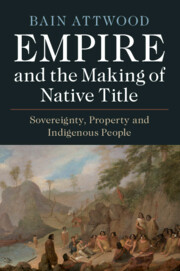Book contents
- Empire and the Making of Native Title
- Empire and the Making of Native Title
- Copyright page
- Dedication
- Contents
- Acknowledgements
- Abbreviations
- Principal Players
- Maps
- Introduction
- 1 Claiming Possession in New Holland and New Zealand, 1770s–1820s
- 2 Batman’s Treaty and the Rise and Fall of Native Title, 1835–1836
- 3 The South Australian Colonisation Commission, the Colonial Office and Aboriginal Rights in Land, 1834–1837
- 4 Protection Claims and Sovereignty in the Islands of New Zealand, 1800–1839
- 5 Making Agreements and a Struggle for Authority, 1839–1840
- 6 The Land Claims Commission and the Return of the Treaty, 1840–1843
- 7 A Colony in Crisis and a Select Committee, 1843–1844
- 8 The Retreat of the Government and the Rise of the Treaty, 1844–1845
- 9 The Making of Native Title, 1845–1850
- Conclusion
- Appendix: The English Text of the Treaty of Waitangi
- Bibliography
- Index
4 - Protection Claims and Sovereignty in the Islands of New Zealand, 1800–1839
Published online by Cambridge University Press: 03 July 2020
- Empire and the Making of Native Title
- Empire and the Making of Native Title
- Copyright page
- Dedication
- Contents
- Acknowledgements
- Abbreviations
- Principal Players
- Maps
- Introduction
- 1 Claiming Possession in New Holland and New Zealand, 1770s–1820s
- 2 Batman’s Treaty and the Rise and Fall of Native Title, 1835–1836
- 3 The South Australian Colonisation Commission, the Colonial Office and Aboriginal Rights in Land, 1834–1837
- 4 Protection Claims and Sovereignty in the Islands of New Zealand, 1800–1839
- 5 Making Agreements and a Struggle for Authority, 1839–1840
- 6 The Land Claims Commission and the Return of the Treaty, 1840–1843
- 7 A Colony in Crisis and a Select Committee, 1843–1844
- 8 The Retreat of the Government and the Rise of the Treaty, 1844–1845
- 9 The Making of Native Title, 1845–1850
- Conclusion
- Appendix: The English Text of the Treaty of Waitangi
- Bibliography
- Index
Summary
The British government’s decision in 1839 to seek the consent of native chiefs to its assumption of sovereignty in the islands of New Zealand cannot be explained adequately by reference to international law, European political thought or Christian humanitarianism. It owed a great deal instead to strategic and political considerations and a complex sequence of historical events that took place in the preceding seventy years. The decision to treat with the chiefs for sovereignty was in large part a function of protection talk that generated a status for Māori as being more or less an ally of Britain and brought into being a relationship of mutual protection between the chiefs and the British Crown. At the same time, small parties negotiated with natives to purchase land from the outset of European settlement, and later groups of European adventurers and land-grabbers followed suit. At the point the Colonial Office reluctantly accepted that the British government had to intervene and assume sovereignty, the long history of encounter in New Zealand persuaded it that the means required to make a treaty were available in the form of chiefs as interlocutors and missionaries as go-betweens.
Keywords
- Type
- Chapter
- Information
- Empire and the Making of Native TitleSovereignty, Property and Indigenous People, pp. 96 - 139Publisher: Cambridge University PressPrint publication year: 2020



